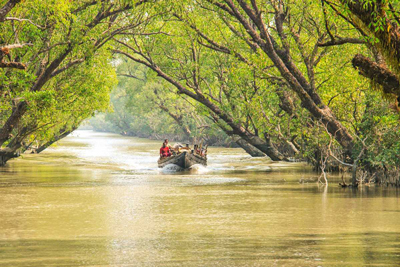
Located in World's largest Delta formed by the confluence of the rivers Ganga, Brahmaputra and Meghna, Sundarbans National Park, a part of the large coastal mangrove forest of the Sundarbans, shared by West Bengal in India and Bangladesh, is a World Heritage site, a Biosphere reserve and home to a large number of Royal Bengal tigers, enriched by roaring rivers and beautiful estuaries.
Known for hosting the biggest mangrove forests in the world and named after the Sundari trees, a species of mangrove tree found in abundance in the area, which can grow up to 60 feet in height with a girth of six feet, the park, created in 1984 as a core area within the larger Sundarbans Tiger Preserve, has an area of 514 square miles (1,330 square km) and is located around 110 Km south of Calcutta, the capital city of West Bengal, India. Intersected by several distributaries of the River Ganga or Ganges, Sundarbans National Park is composed of 102 islands, among which 54 are inhabited. While islands like Goasaba, Sandeshkali and Basanti form the northern boundary of the Sundarbans area and the Bay of Bengal lies to its south, the Matla and Bidyadhari Rivers form its eastern boundary and the international boundary of Bangladesh is to its west.

Seven main rivers with southward course towards the sea and innumerable watercourses form a network of channels in the delta area and the eco-geography of this area is totally dependent on the tidal effects of two high tides and two low tides of the rivers, occurring within 24 hours, which deposit silts back on the channels, raising the bed and ultimately forming new islands.
Mudflats are found at the estuary and on the deltaic islands, formed and maintained by sediment supply delivered from the surrounding river channels, which are exposed during low tides and submerged during high tides, creating an ideal environment for mangroves. The average minimum and maximum temperature in the area is 20 °C and 48 °C respectively, while rainfall is heavy with humidity as high as 80%, due to the nearness of the Bay of Bengal.

During the months of May to October, sometimes storms develop into cyclones, creating havoc in the coastal area. On 25 May 2009, Cyclone Aila struck Sundarbans, when the fringe villages bordering the reserve were heavily damaged, leaving thousands of people marooned and the field camps were under 12 to 15 feet of water for around seven hours, resulting in soil erosion and damage to staff quarters, generators and bamboo pilings.
After that, on 20 May 2020, Cyclone Amphan made landfall near the Sagar Island and damaged almost the entire nylon fencing in the forest which prevents the tigers from entering the forest-fringe villages, apart from damaging dozens of forest camp offices, tents, watch towers and staff quarters.

The vast Sundarbans National Park, along with an incredible variety of flora and fauna, exudes an aura of mystery, which unfolds itself with every single visit. Around 64 plant species that are found in the park area have learned to survive in brackish waters and saline inundation. It is estimated that there are about 78 species of mangroves in these forests, among which the Sundari tree has specialised roots called Pneumatophores or Aerial roots that grow out of the water surface to facilitate root respiration, when the entire forest is waterlogged. Other common species of plants found in the park include, among others Hental, Genwa,Garjan, Goran, Keora, Garia, Golpati, Champa, Dhundul and Baine.

Apart from the majestic Royal Bengal Tigers, the Sundarbans National Park provides habitat for many predator species like leopards, jungle cats, fishing cats and leopard cats. Other animals found in these areas are macaques, Indian grey mongoose, wild boar, flying fox, pangolin, Indian grey mongoose, spotted deer, chital deer and rhesus monkeys. Sundarban is also famous for its marine life, which include among others, Gangetic dolphins, numerous varieties of fishes, lobsters, shrimps, crabs, red fiddler crabs, hermit crabs and various types of turtles like Indian black turtle, olive Ridley turtles, green turtles and hawksbill sea turtles. Some of the reptile species found in the park area are gharials, salt water crocodiles, estuarine crocodiles, chameleons, monitor lizards, king cobras, russels vipers, mouse geckos, dog-faced snakes, pythons and many more. It is estimated that in Sundarbans, around 100 to 200 people die each yeardue to snake bites.

Sunderban National Park is considered as a heaven for bird watchers, which include more than 200 bird species like kingfishers, herons, woodpeckers, storks, Brahmin ducks, ibises, arghilahs, water fowl, egrets, open-billed storks, pariah kites, brahminy kites, common snipes, Caspian terns, marsh harriers, swamp partridges, peregrine falcons, red jungle fowl, black-headed ibis, white-bellied sea eagles and others. The Sajnakhali sanctuary, considered a part of the Sunderbans National Park and known for its diverse bird population, is a popular tourist destination for watching various types of birds from its watch tower.